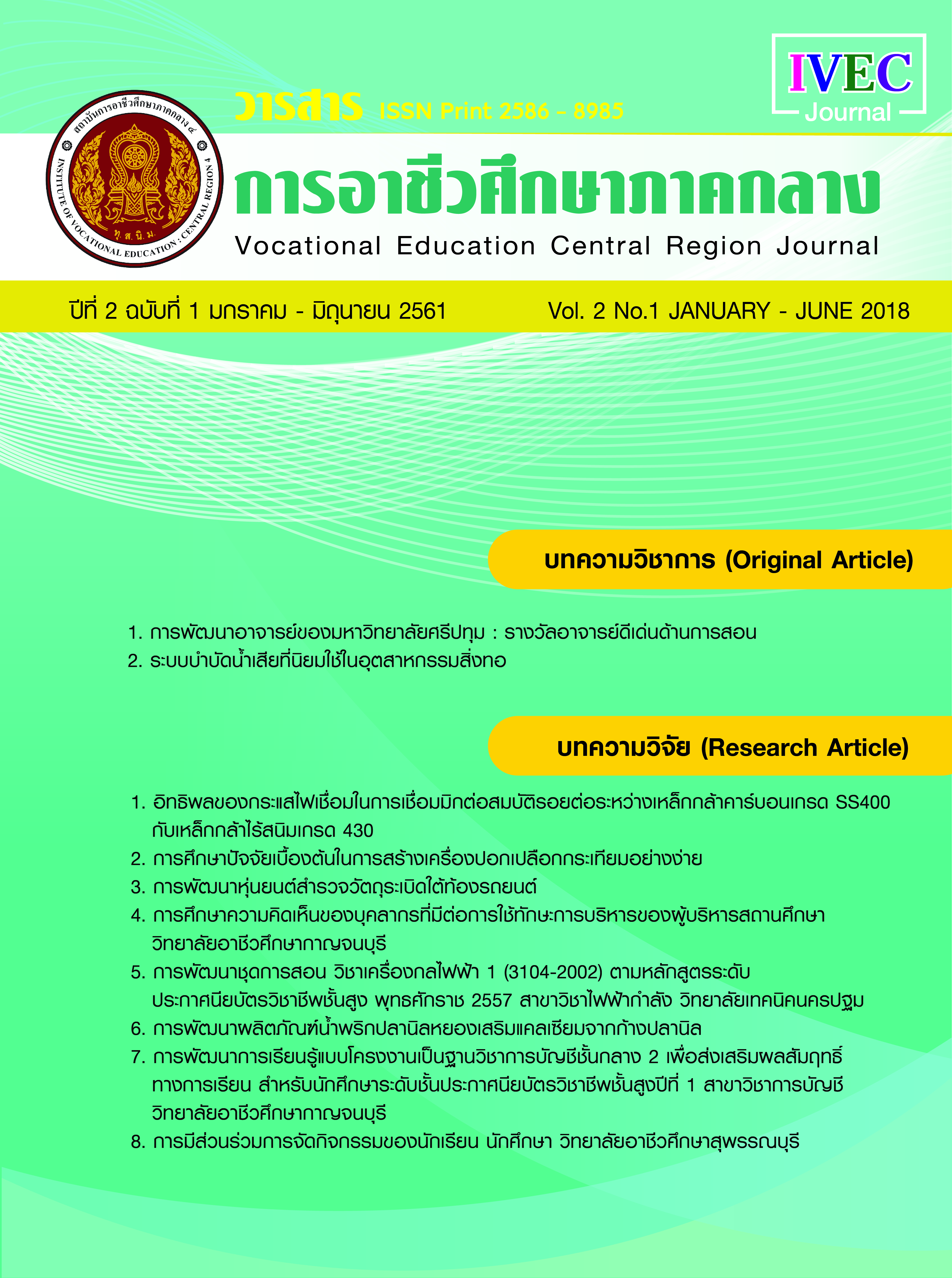A study of basic factors in creating a simple Garlic peeling machine
Main Article Content
Abstract
The research objectives were: 1) To study the basic factors in creating a simple garlic peeling machine 2) To test the efficiency of the simple garlic peeling machine 3) To assess further comments for using a simple garlic peeling machine. The scope of beginning variable of this research was a plastic water bottle with a capacity of 1,100 - milliliters, circular tough plastic 1,100 and 1,500-milliliters. We used cloves of Chinese garlic as raw materials for experiments by an air pressure of 1 to 8 bars in size.
From the research, we found out that the 1,100-milliliters plastic bottle with tilted air outlet could peel 100 grams of garlic cloves. But the 1,100 and 1,500-milliliters circular tough plastic bottles with side air outlet could peel more garlic cloves for about 200 and 150 grams of garlic, respectively. For the circular tough plastic bottle 1,100-milliliters with side air outlet was best in peeling garlic cloves. It can peel up to 200 grams of garlic cloves with air pressure of 1 to 8 bars. The standard air pressure for this experiment was 3 bars. In the study of the efficiency of the garlic peeling machine, it was found that the peeling can be done not less than 80%. The surface of each peeled garlic clove was smoot and its flesh intact. The device is more efficient than manual effort. It could work faster than the human hands in peeling garlic cloves at 2.5 times. Therefore, the device has also helped to increase income to more than twice the usual. In evaluating users satisfaction on the use of simple peelers by disseminating and experimenting in the community of Prachinburi Province was at a high level ( = 4.3), the opinions for the garlic peeling machine was at the highest level (
= 4.6)
Article Details
|
บทความ ข้อมูล เนื้อหา รูปภาพ ฯลฯ ที่ได้รับการตีพิมพ์ในวารสาร การอาชีวศึกษาภาคกลาง ถือเป็นลิขสิทธิ์ของวารสารการอาชีวศึกษาภาคกลางหากบุคคลหรือหน่วยงานใดต้องการนำทั้งหมดหรือส่วนใดส่วนหนึ่ง ไปเผยแพร่ต่อหรือเพื่อกระทำการใด ๆ กองบรรณาธิการไม่สงวนสิทธิ์ ในการคัดลอกบทความเพื่อการศึกษาแต่ให้อ้างอิงแหล่งที่มาให้ครบถ้วน สมบูรณ์ สงวนสิทธิ์ โดย สถาบันการอาชีวศึกษาภาคกลาง 4 ที่ตั้ง 90 ถนนเทศา ตำบลพระปฐมเจดีย์ อำเภอเมือง จังหวัดนครปฐม โทรศัพท์ 034 242 856 , โทรสาร 034 242 858 ISSN : 3056-9176 (print) ISSN : 2985-2382 (online) |
References
2. ทรงสิทธิ์ พรหมลา และธีรวัฒน์ แก่นวงษ์. (2558). เครื่องปอกเปลือกกระเทียมกลีบโดยใช้ลมความดันสูง. ปริญญานิพนธ์วิศวกรรมศาสตรบัณฑิต สาขาวิศวกรรมศาสตร์ชีวภาพ มหาวิทยาลัยมหาสารคาม.
3. ธีรวัฒน์ พีบขุนทด. (2559). การพัฒนาและสร้างเครื่องปอกเปลือกกลีบกระเทียม. ปริญญาวิศวกรรมศาสตรมหาบัณฑิตสาขาวิชาวิศวกรรมเครื่องกล มหาวิทยาลัยมหาสารคาม.
4. นาตยา คิชันธร. (2552). เครื่องปอกกระเทียมออนไลน์. ค้นเมื่อ กุมภาพันธ์, 4, 2552. จาก : http://www.dailynews.co.th.
5. พีรเดช มีสานุ. (2557). โครงสร้างถังปอกกระเทียมที่ได้รับการปรับปรุงทิศทางของกระแสลม. กรุงเทพฯ: กรมทรัพย์สินทางปัญญา กระทรวงพาณิชย์ เลขที่อนุสิทธิบัตร 9595.
6. วิไล รังสาดทอง. (2557). เทคโนโลยีการแปรรูปอาหาร. พิมพ์ครั้งที่ 6. กรุงเทพฯ: ภาควิชาเทคโนโลยีอุตสาหกรรมเกษตร อาหารและสิ่งแวดล้อม คณะวิทยาศาสตร์ประยุกต์ สถาบันเทคโนโลยีพระจอมเกล้าพระนครเหนือ.
7. ศุภยศ สุวีพัฒนานนท์. (2554). อุปกรณ์ช่วยในการปอกเปลือกกระเทียม. กรุงเทพฯ: กรมทรัพย์สินทางปัญญากระทรวงพาณิชย์ เลขที่อนุสิทธิบัตร 8822.
8. สัมพันธ์ ศรีสุริยวงษ์. (2551). เครื่องปอกเปลือกกระเทียม. กรุงเทพฯ: กรมทรัพย์สินทางปัญญา กระทรวงพาณิชย์.
9. อภิชาต จิรัฐติยางกูร และสุวัฒน์ ตัณฑ์ศรี. ( 2545). การออกแบบและสร้างเครื่องจักรแปรรูปกระเทียมครบวงจร.ว. วิศวกรรมสาร มก. 16(46), หน้า 117-124.
10. อภิชาต จิรัฐติยางกูร และอภิวัฒน์ มงคลแถลง. ( 2551). เครื่องปอกเปลือกกลีบกระเทียมด้วยกลไกมือ. วิศวกรรมสาร มก. 21. (65) หน้า 70-78.
11. Manjunatha, M., D.V.K., Anurag, R.K. and Gaikwad, N. (2014). Development and performance Evaluation of a garlic peeler. Food Science. 51 (11), หน้า 3083-3093.


